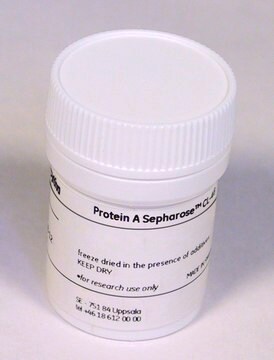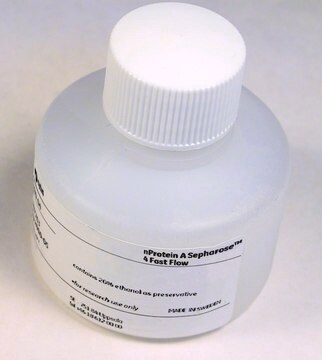GE17-0618-01
Protein G Sepharose™ 4 Fast Flow
Cytiva 17-0618-01, pack of 5 mL
Synonym(s):
Fast Flow resin, Antibody purification resin, IgG purification resin
About This Item
Recommended Products
ligand
recombinant protein G lacking albumin-binding region
packaging
pack of 5 mL
manufacturer/tradename
Cytiva 17-0618-01
storage condition
(20% Ehtanol)
matrix
4% cross-linked agarose
average diameter
90 μm (d50v)
cleaning in place
2-10
working range
3-9
suitability
suitable for bioprocess medium
storage temp.
2-8°C
Related Categories
General description
Protein G Sepharose™ 4 Fast Flow has recombinant protein G immobilized by the cyanogen bromide (CNBr) method to Sepharose™ 4 Fast Flow. Protein G exhibit binding specificities that complement Protein A media and binds to the Fc region of IgG from a variety of mammalian species. Protein G Sepharose™ 4 Fast Flow may be used to isolate and purify classes, subclasses and fragments of immunoglobulins from any biological fluid or cell culture medium.
As member of the BioProcess media range, Protein G Sepharose™ 4 Fast Flow meets industrial demands with security of supply and comprehensive technical and regulatory support.
Features and Benefits
- Binding specificities that complement Protein A media.
- Binds a broad range of IgG species and subclasses.
- Multi-point attachment minimizes ligand leakage.
- Used in a range of research applications.
Storage and Stability
Analysis Note
Legal Information
related product
Signal Word
Warning
Hazard Statements
Precautionary Statements
Storage Class Code
3 - Flammable liquids
Choose from one of the most recent versions:
Certificates of Analysis (COA)
It looks like we've run into a problem, but you can still download Certificates of Analysis from our Documents section.
If you need assistance, please contact Customer Support.
Already Own This Product?
Find documentation for the products that you have recently purchased in the Document Library.
Customers Also Viewed
Articles
This page shows a comparison of the relative binding strengths of protein G and protein A to different immunoglobulins.
This page shows how to perform a separation with the HiTrap Protein G HP from GE Healthcare, an Affinity Exclusion Chromatography product containing pre-packed Protein G.
This page describes immunoprecipitation (immunoaffinity or pull-down techniques).
This page describes efficient column packing and preparation for affinity chromatography of antibodies.
Protocols
This page provides information about different pull-down assays for the further isolation of multiprotein complexes to identify their components with products from GE Healthcare.
This page shows how to separate IgG antibodies by affinity chromatography using Protein G Sepharose 4 Fast Flow from GE Healthcare.
This page shows how to separate IgG antibodies by affinity chromatography using Protein G Sepharose 4 Fast Flow from GE Healthcare.
This page shows how to prepare samples for purification with affinity chromatography.
Related Content
Pull-down assays, reagents, and protocols for investigating in vitro protein-protein interactions using affinity or GST pull-down, tandem affinity purification (TAP), and co-immunoprecipitation methods.
Our team of scientists has experience in all areas of research including Life Science, Material Science, Chemical Synthesis, Chromatography, Analytical and many others.
Contact Technical Service







